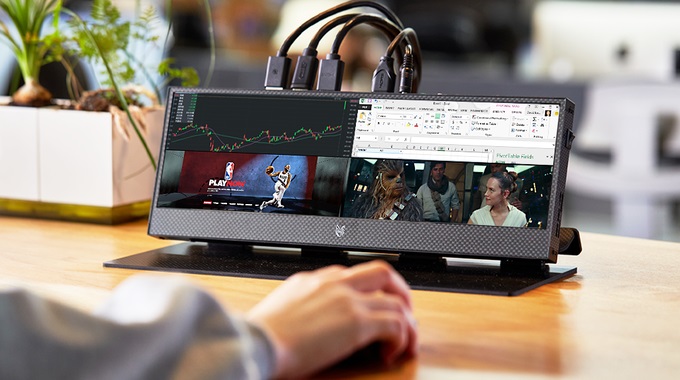Just when you think you’ve seen it all when it comes to technology, a new product always pops up to challenge that belief. This display is one of them.
The Lukos Ultrawide 4K monitor is a 14-inch portable screen aimed at gamers, but it’s unlike any of the other ultrawide monitors you’ve ever seen. It’s certainly one of the weirdest displays to hit the market, and while it comes with a few fun perks, it’s hard to say how useful it may prove to be in the long run.

The company advertises the monitor as a one-of-a-kind portable display, and just one look at the photos proves that yes, this is a unique model. It has an odd aspect ratio of 32:9, measures 14-inches, and has a resolution of 3840 x 1100. It can be rotated to be horizontal or vertical, and the protective stand it’s attached to offers multiple angle adjustments.
Lukos Ultrawide sports an IPS panel, promising pleasing visuals, and up to 300 nits of brightness. For reference, most laptops offer anywhere between 200 and 600 nits, so this screen falls somewhere in the middle. On the other hand, proper stand-alone monitors can hit much higher figures, such as the Samsung QLED Odyssey with up to 2,000 nits. Obviously, we cannot expect that kind of performance from a portable screen.
The company claims that the screen will also feature a 2ms response time and a 60Hz refresh rate. It supports multi-view, letting you watch up to four different things at the same time. VideoCardz notes that this would add up to four 1920 x 550 views.
While Lukos tries to market this monitor as a gaming device, it’s difficult to imagine it as a go-to for gamers. With the strange aspect ratio and resolution, as well as a refresh rate of just 60Hz, it’s not here to compete with the best gaming monitors. Then again, being a portable display, it stands in a category of its own and could prove to be useful for gaming on the go. Perhaps some gamers would enjoy this Lukos screen, but it seems more suited for productivity as a secondary screen for things like hardware monitoring.

In terms of connectivity, Lukos both wins and loses. It wins due to a large number of ports: One DisplayPort 1.2, two DisplayPorts 1.4, one HDMI 1.4, and two HDMI 2.0B. It also comes with a USB Type-C connector and a 12V power port. Lukos promises that the monitor can be used for anything from laptops to consoles. Unfortunately, all of the ports are placed at the top of the monitor, which could make for somewhat awkward cable management.
A screen of this type almost begs for touch controls, but it only features buttons for the on-screen menu. It also has built-in speakers and a cooling system of its own that can be enabled or disabled by the user.
It’s important to note that this display is still not fully released as a product, and all we have to go on is information directly from the company itself. It’s currently being advertised on Kickstarter, and the fundraising campaign is nearing its end, having met its financing goal. Backers can pledge at least $419 to receive one of the monitors in April 2022, or $758 for a duo-pack of the displays. Later on, customers will have to pay at least $479 for one display.
While the campaign sounds interesting, think twice before you back any Kickstarter project. It may come to fruition and you may receive your monitor, but there is no guarantee when it comes to its performance until the device is tested by independent third parties.



